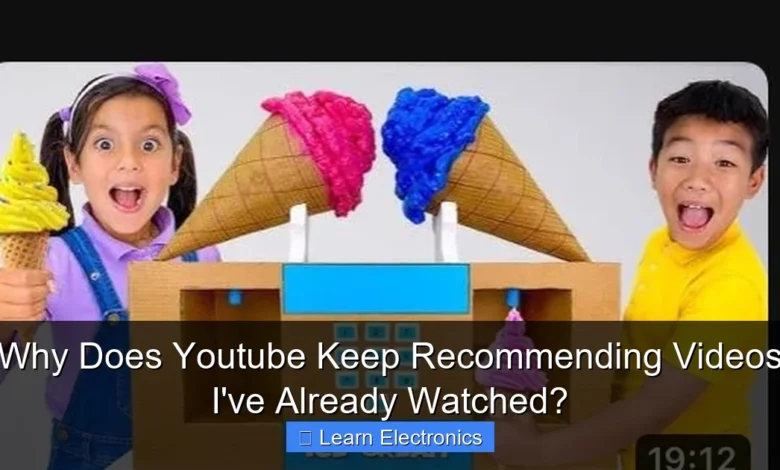Why Does Youtube Keep Recommending Videos I’ve Already Watched?

Why Does YouTube Keep Recommending Videos I’ve Already Watched? This common phenomenon is not a glitch, but rather an intentional function of YouTube’s sophisticated recommendation algorithm, designed to maximize your watch time and engagement. The platform’s system prioritizes content it believes you are most likely to watch again or interact with, based on a complex interplay of your past viewing habits and other subtle cues.
This approach, while sometimes frustrating, serves the platform’s core objective: keeping you on the site. It uses various signals, including watch duration, re-watches, and even how recently you last engaged with a particular video or channel, to surface familiar content.
Quick Answers to Common Questions
Why does YouTube keep recommending videos I’ve already watched?
YouTube’s algorithm sometimes prioritizes content that’s highly popular, trending, or closely related to your current interests, even if you’ve already watched it. It might think you’re interested in re-watching or that you missed something, leading to recommendations for videos you’ve already watched.
Can I stop YouTube from recommending videos I’ve already watched?
Absolutely! You can actively tell YouTube you’ve already watched a video by clicking the three dots next to the recommendation and selecting ‘Not interested’ or ‘Don’t recommend channel.’ This feedback helps YouTube learn your preferences better and reduces how often you see videos you’ve already watched.
Does YouTube know I’ve watched it, or is its memory bad?
YouTube generally *does* know if you’ve watched a video, especially if it’s in your watch history and you completed it. Often, recommendations for videos you’ve already watched stem from an algorithm trying to re-engage you with popular content or suggesting you re-watch something relevant to a new search.
📑 Table of Contents
- The Algorithm’s Intent: Maximizing Your Watch Time
- How Your Watch History Influences Recommendations
- The Role of Related Content and Session History
- Content Refresh Cycles and Creator Strategies
- Why Does YouTube Keep Recommending Videos I’ve Already Watched? Taking Control of Your Feed
- Beyond the Algorithm: When Repetition Becomes Problematic
The Algorithm’s Intent: Maximizing Your Watch Time
At its core, YouTube’s recommendation algorithm is built to achieve one primary goal: keep you watching. Every suggestion it makes, whether new or old, is a calculated attempt to predict what will most likely capture your attention and retain it. The system isn’t simply showing you what’s new; it’s showing you what’s *engaging*.
The Pursuit of Engagement
Engagement isn’t just about clicks; it’s about watch time, likes, comments, and shares. If you previously watched a video all the way through, liked it, or commented on it, the algorithm takes that as a strong signal of high engagement. It interprets this behavior as a sign that you might be interested in watching it again, perhaps to catch details you missed, or simply because you enjoyed the content so much the first time. The algorithm assumes a high probability of re-engagement with content that previously held your attention.
Reinforcing Familiarity and Comfort
Humans often gravitate towards the familiar. YouTube capitalizes on this psychological tendency by occasionally re-introducing content you’ve already consumed. This practice can be seen as a comfort-seeking mechanism; if you’re feeling indecisive about what to watch next, a video you know you enjoyed is a safe, easy choice. The algorithm leverages this by offering known quantities, reducing the cognitive load of selecting something entirely new and potentially unsatisfying.
How Your Watch History Influences Recommendations
Your watch history is the single most significant data point YouTube’s algorithm uses to tailor recommendations. Every video you watch, how long you watch it, and how you interact with it, feeds directly into the system’s understanding of your preferences. This deep analysis forms the bedrock of its suggestion engine.
Deep Dive into Your Viewing Habits
When you watch a video, YouTube records not just that you watched it, but also the duration of your view. Did you click away after 30 seconds, or did you stay for the entire 15-minute documentary? The latter signals a much stronger interest. Furthermore, if you re-watch parts of a video, or even the entire thing multiple times, this behavior is a powerful indicator that you genuinely value the content. The algorithm might then push that video, or very similar ones, back into your feed, even if you’ve seen it before, simply because it knows you respond positively to this type of content.
The “Finished” vs. “Partially Watched” Conundrum
The algorithm makes a distinction between videos you’ve finished and those you’ve abandoned. If you frequently stop watching videos halfway through, YouTube learns that you might be interested in the topic but that particular video didn’t hold your attention. However, if you’ve finished a video, the system registers it as a complete consumption. In some cases, if a video is particularly long or complex, the algorithm might even assume you might want to revisit it later to absorb all the information, leading to a re-recommendation. This detailed understanding of your completion rate informs future suggestions, including the re-promotion of content you’ve seen.
The Role of Related Content and Session History
Beyond your direct watch history, YouTube’s algorithm also considers the broader context of your viewing sessions and the behavior of other users with similar interests. These factors create an intricate web of connections that can bring previously watched videos back into your orbit.
The Echo Chamber Effect
When you watch a series of videos on a particular topic within a single session, the algorithm begins to group them. If one of those videos happens to be something you’ve watched before, but it fits perfectly into the current “theme” of your viewing session, YouTube might recommend it again. This “echo chamber” effect ensures that once you’re on a certain track, the platform helps you stay there, even if it means revisiting familiar ground. This technique aims to maintain a consistent viewing experience, assuming your current interest aligns with past successful engagements.
What Other Viewers Like You Watch
YouTube aggregates data from millions of users. If many viewers who share your watch patterns and preferences also tend to re-watch certain videos or view them in specific sequences, the algorithm might learn from this collective behavior. It then applies this knowledge to your recommendations. So, if a cohort of “users like you” frequently revisits a particular educational video, the system might deduce that you, too, would benefit from a second viewing, even if it’s not immediately obvious why you would want to.
Content Refresh Cycles and Creator Strategies
Sometimes, the reappearance of old videos in your feed isn’t solely about your viewing habits but also about how creators manage their content and how YouTube handles “evergreen” material. The platform’s dynamic nature means older videos can gain new life.
Evergreen Content and Its Resurgence
Certain videos are considered “evergreen” – their relevance doesn’t diminish over time. Tutorials, how-to guides, educational content (especially in fields like electronics where foundational knowledge remains constant), and timeless discussions fall into this category. YouTube’s algorithm recognizes the enduring value of such content. If an evergreen video starts to pick up new engagement (likes, comments, shares) from new viewers, or if its topic becomes suddenly popular again, the algorithm may resurface it to a wider audience, including those who have seen it before. This practice ensures valuable content continues to reach relevant viewers, regardless of its original upload date.
Creator Engagement Tactics
Creators themselves play a role. They might re-promote older, successful videos on social media, in community posts, or even by linking them in new content. This fresh external engagement can signal to YouTube’s algorithm that the video is experiencing a renewed interest surge. Consequently, the platform might include it in recommended feeds, treating it almost like new content due to its recent spike in attention. Some creators might also optimize older videos with updated titles, thumbnails, or tags, which can trigger the algorithm to re-evaluate and re-distribute them.
Why Does YouTube Keep Recommending Videos I’ve Already Watched? Taking Control of Your Feed
While YouTube’s algorithm is powerful, you are not entirely at its mercy. There are several proactive steps you can take to influence your recommendations and reduce the frequency of seeing videos you’ve already consumed.
Using “Not Interested” and “Don’t Recommend Channel”
YouTube provides direct feedback mechanisms that you should utilize. When you see a video you’ve already watched and don’t wish to see again, click the three-dot menu next to the video title. You’ll typically find options like “Not interested” or “Don’t recommend channel.” The “Not interested” option tells the algorithm to specifically stop recommending that particular video. “Don’t recommend channel” is a stronger signal, instructing YouTube to avoid showing any content from that specific creator in your main feed.
Clearing Watch History and Search Data
For a more drastic reset, consider clearing your watch history. You can do this in your YouTube settings under “History & privacy.” You can also pause your watch history entirely. Similarly, clearing your search history can prevent the algorithm from reinforcing old interests. While this might temporarily make your recommendations feel generic, it provides a clean slate for the algorithm to learn new preferences based on your subsequent viewing choices.
Exploring New Topics and Channels
Actively diversify your viewing habits. Seek out new channels, explore different categories, and watch videos on topics you wouldn’t normally consider. The more varied your recent watch history, the less likely the algorithm is to fall back on old, already-watched content. This proactive exploration is a powerful way to train the algorithm to understand a broader range of your interests.
Beyond the Algorithm: When Repetition Becomes Problematic
While the algorithmic tendency to resurface watched content is designed for engagement, it can sometimes lead to a stagnant and uninspiring viewing experience. Recognizing when this repetition becomes a problem is key to regaining control.
Understanding the Recurrence: Why Does YouTube Keep Recommending Videos I’ve Already Watched?
The core reason for this recurrence is the algorithm’s learning model: it learns from what it knows works. If a video previously held your attention, even if you’ve seen it, the probability of it succeeding again (in terms of drawing your eye, even for a moment) is higher than an unknown video. This makes the system efficient but also prone to loops. For users seeking fresh content, this can lead to frustration and the feeling that the platform isn’t offering anything new.
The Monotony Trap
Continuously seeing the same videos or content from the same narrow set of creators can lead to a sense of monotony. It limits your exposure to new ideas, different perspectives, and emerging trends. This “monotony trap” can make YouTube feel less dynamic and exciting, potentially driving users away who are seeking novelty and diverse content.
The Need for Fresh Perspectives
To combat this, users need to be intentional about their consumption. Using the feedback tools, actively seeking new content, and even periodically “detoxing” from familiar channels can help reset the algorithm. The goal is to signal to YouTube that your interests are evolving and that you prefer variety over constant reinforcement of known successful content. By taking these steps, you guide the algorithm towards a more diverse and stimulating viewing experience.
| User Action | Algorithmic Interpretation | Impact on Recommendations |
|---|---|---|
| Watching a video to completion | High interest, high engagement | Increased chance of similar content, re-recommendations of same video |
| Re-watching a video multiple times | Very high interest, strong preference | Significant boost for that video and channel, deep dives into related topics |
| Liking or commenting on a video | Positive sentiment, active engagement | Reinforces preference for content type and creator |
| Clicking “Not interested” | Negative feedback for specific video | Reduces recommendations for that video, slight reduction for similar content |
| Clicking “Don’t recommend channel” | Strong negative feedback for channel | Significantly reduces recommendations from that channel across the platform |
| Watching new, diverse content | Expanding interests | Algorithm adapts, introducing more varied content, reducing reliance on old patterns |
In conclusion, when YouTube recommends videos you’ve already watched, it’s rarely a mistake. It’s a calculated move by a highly optimized algorithm, leveraging your past engagement, the behavior of similar viewers, and content refresh cycles to keep you glued to the screen. By understanding this intricate system and utilizing the tools YouTube provides, you can actively shape your recommendation feed, guiding it towards a more personalized and less repetitive viewing experience.
Frequently Asked Questions
Why does YouTube keep recommending videos I’ve already watched?
This often happens because YouTube’s algorithm prioritizes engagement and watch time. If you watched a video completely, engaged with it, or watched similar content, the system might interpret it as something you’re highly interested in and offer it again, especially if there’s no newer, equally relevant content.
How can I stop YouTube from recommending videos I’ve already watched?
The most effective way is to use the “Not interested” or “Don’t recommend channel” options directly on the video thumbnail. You can also clear your watch history or pause it, but be aware this will affect all recommendations, not just repeats.
Does watching a video multiple times encourage YouTube to recommend it again?
Yes, watching a video multiple times strongly signals to YouTube’s algorithm that you have a high interest in that particular content. This can increase the likelihood of the system recommending the same video or very similar content to you in the future.
Why do I see videos I watched a long time ago reappear in my recommendations?
YouTube might re-recommend older content if it detects renewed interest in a topic you previously engaged with, or if the video recently gained new traction. It could also be a popular evergreen video within a category you frequently watch, making it a recurring suggestion.
What steps can I take to improve my recommendations and reduce repeated videos?
Regularly use the “Not interested” feedback option on redundant videos and clear your watch history for content you don’t want to influence future suggestions. Actively searching for new channels and topics can also broaden your recommendation pool, showing you more diverse options.
Could my YouTube watch history or search history settings be causing these repeated recommendations?
Absolutely. If your watch history is enabled and shows a strong preference for certain videos or topics, the algorithm will lean heavily on that data. Pausing or clearing specific entries from your watch and search history can help reset and diversify your recommendations, reducing repeats.



